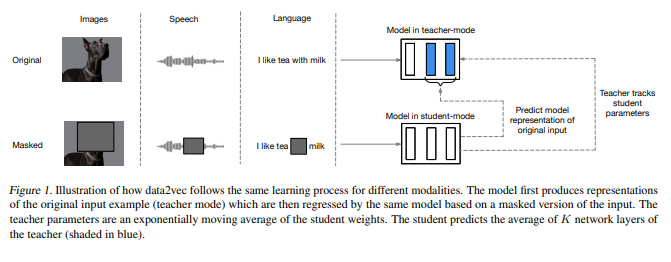Data2Vec-Text base model
Pretrained model on English language using the data2vec objective. It was introduced in this paper and first released in this repository. This model is case-sensitive: it makes a difference between english and English.
Disclaimer: The team releasing Data2Vec-Text did not write a model card for this model so this model card has been written by the Hugging Face team.
Pre-Training method
For more information, please take a look at the official paper.
Abstract
While the general idea of self-supervised learning is identical across modalities, the actual algorithms and objectives differ widely because they were developed with a single modality in mind. To get us closer to general self-supervised learning, we present data2vec, a framework that uses the same learning method for either speech, NLP or computer vision. The core idea is to predict latent representations of the full input data based on a masked view of the input in a selfdistillation setup using a standard Transformer architecture. Instead of predicting modality-specific targets such as words, visual tokens or units of human speech which are local in nature, data2vec predicts contextualized latent representations that contain information from the entire input. Experiments on the major benchmarks of speech recognition, image classification, and natural language understanding demonstrate a new state of the art or competitive performance to predominant approaches.
Intended uses & limitations
The model is intended to be fine-tuned on a downstream task. See the model hub to look for fine-tuned versions on a task that interests you.
Note that this model is primarily aimed at being fine-tuned on tasks that use the whole sentence (potentially masked) to make decisions, such as sequence classification, token classification or question answering. For tasks such as text generation you should look at model like GPT2.
Training data
The RoBERTa model was pretrained on the reunion of five datasets:
- BookCorpus, a dataset consisting of 11,038 unpublished books;
- English Wikipedia (excluding lists, tables and headers) ;
- CC-News, a dataset containing 63 millions English news articles crawled between September 2016 and February 2019.
- OpenWebText, an opensource recreation of the WebText dataset used to train GPT-2,
- Stories a dataset containing a subset of CommonCrawl data filtered to match the story-like style of Winograd schemas.
Together theses datasets weight 160GB of text.
BibTeX entry and citation info
@misc{https://doi.org/10.48550/arxiv.2202.03555,
doi = {10.48550/ARXIV.2202.03555},
url = {https://arxiv.org/abs/2202.03555},
author = {Baevski, Alexei and Hsu, Wei-Ning and Xu, Qiantong and Babu, Arun and Gu, Jiatao and Auli, Michael},
keywords = {Machine Learning (cs.LG), FOS: Computer and information sciences, FOS: Computer and information sciences},
title = {data2vec: A General Framework for Self-supervised Learning in Speech, Vision and Language},
publisher = {arXiv},
year = {2022},
copyright = {arXiv.org perpetual, non-exclusive license}
}
- Downloads last month
- 963
